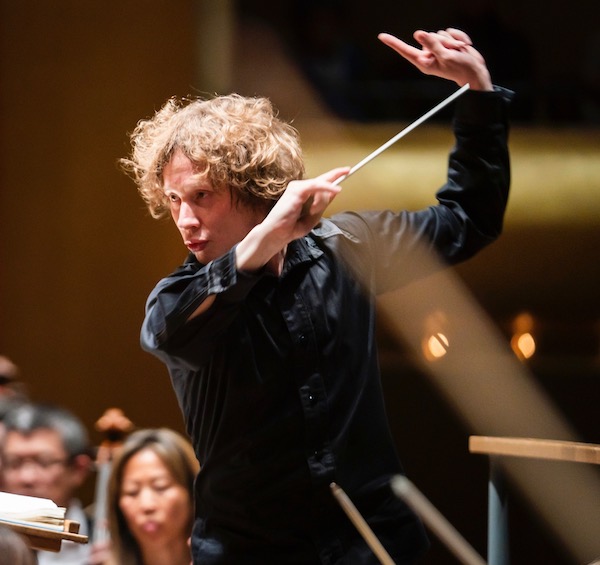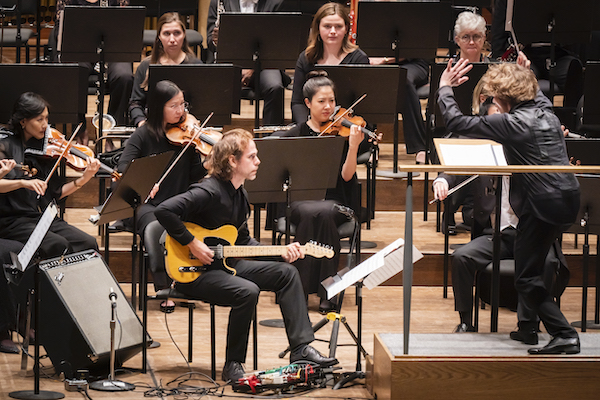Dessner’s “Wires” get crossed but Rouvali strikes sparks in Philharmonic debut

It was a weekend of newness for the New York Philharmonic, with two up-and-comers in orchestral music making closely watched debuts at David Geffen Hall: Finnish conductor Santtu-Matias Rouvali, 34; and American composer Bryce Dessner, 43, best known as a founder of the Grammy-winning rock band The National.
Rouvali and Dessner were combining their talents for the New York premiere of a Dessner composition, Wires, a novel pairing of orchestral forces with electric guitar. Dessner had the distinction of being the first electric guitarist to solo with the New York Philharmonic in a work written expressly for full orchestra.
The program placed him in between a pair of classical pillars, Tchaikovsky’s Romeo and Juliet Overture-Fantasy and Sibelius’ Symphony No. 1 in E minor, a sequencing that buoyed Dessner but still underscored the limits of entertaining a rocker’s crossover dreams.
On Saturday, in the last of their three performances together, Rouvali conducted and Dessner coaxed a battery of notes and tones from a blonde Fender Telecaster plugged garage band-style into an effects pedalboard and an upturned amp. It was a refreshing sight, and Dessner’s roughly fifteen-minute piece has some writing and sonic imagination to recommend it. But there were also moments where it looked, and sounded, like some lucky dude had just won a raffle to jam out with a real orchestra.

Dessner is an undeniably versatile musician working across popular, experimental and orchestral music as well as film scoring. He’s as familiar by now to the indie-rock tastemakers at Pitchfork as he is to the classical gatekeepers at Gramophone. He founded the cutting-edge MusicNOW festival that showcases contemporary works in The National’s hometown of Cincinnati. He is one of music’s most upstanding citizens, and Wires telegraphs Dessner’s ambition to cross-collaborate and ford boundaries between genres.
There were racing strings, chattering idiophonic lines and clanking, metallic bursts of percussion to go with Dessner’s textural guitar strokes. He wasn’t a soloist in this setting, and as the program notes cautioned, this wasn’t really a concerto — if anything, it was the orchestra doing the lead guitar-style shredding. Rouvali and the Philharmonic gave Dessner’s piece their all, with attentive direction and tight playing, and Wires at its best had a propulsive, splintered quality that recalled the fractal beauty of Esa-Pekka Salonen’s LA Variations.
But Salonen’s musical portrait of an infinite-seeming metropolis has a shape and coherence Wires never quite achieved, and Salonen didn’t require actual electric guitar to convey the electricity of a city. In the end, it wasn’t clear what Dessner and his axe brought to Wires that a traditional orchestral arrangement could not. The great imagined union of classical and rock aesthetic still counts as something of a white whale.
Rouvali’s place on stage was less of a curiosity. Classical’s newest wavy-haired prodigy arrived in New York trailing plaudits and a growing resume: chief conductor of Sweden’s Gothenburg Symphony; principal conductor designate for London’s Philharmonia Orchestra in 2021-2022.
Perhaps not surprisingly, Rouvali demonstrated more affinity Saturday for the work of his countryman Sibelius than for Tchaikovsky’s romantic stand-by. As much as any mainstay by Beethoven, Mahler or Brahms, Sibelius’ First is an archetype of symphonic music. It’s a kind of swan song for Nineteenth Century style, with its four movements and pure diatonic lyricism, and the young Finn was impressive in his management of this 40-minute workhorse.
It was impossible, for starters, not to notice Rouvali, who has a very gestural style. Yet the cues emanating from his movements weren’t random or unintegrated with music, and his physicality wasn’t upstaging.
Rouvali led the Philharmonic confidently, from the lonely clarinet that gives way to the populous opening movement, through the balletic second Andante, the springy Scherzo and an appropriately galvanizing Finale with its whispered last chords. He and the orchestra navigated all of the twists, turns and gradations of volume and arranging that give this symphony its character — determined and heroic, but with an air of humility and uncertainty in the face of a contest.
The rapturous swells of Romeo and Juliet, the concert opener, proved a little more elusive. This was still a handsome vehicle for classical’s most recognized melody, which floats like a dove on an updraft in celebration of youthful bliss (before the teenagers in love become a problem for their warring families). But the flourishes sounded forced and did not land with their usual ravishing bloom. It was a pretty but not quite persuasive reading of an extremely familiar piece. Expect Rouvali to be around long enough to have plenty of opportunities to try again.
The New York Philharmonic season continues with Alisa Weilerstein featured in Saint-Saëns’s First Cello Concerto, and a performance of Dvořák’s Sixth Symphony, November 21-23. 212-875-5656; nyphil.org


